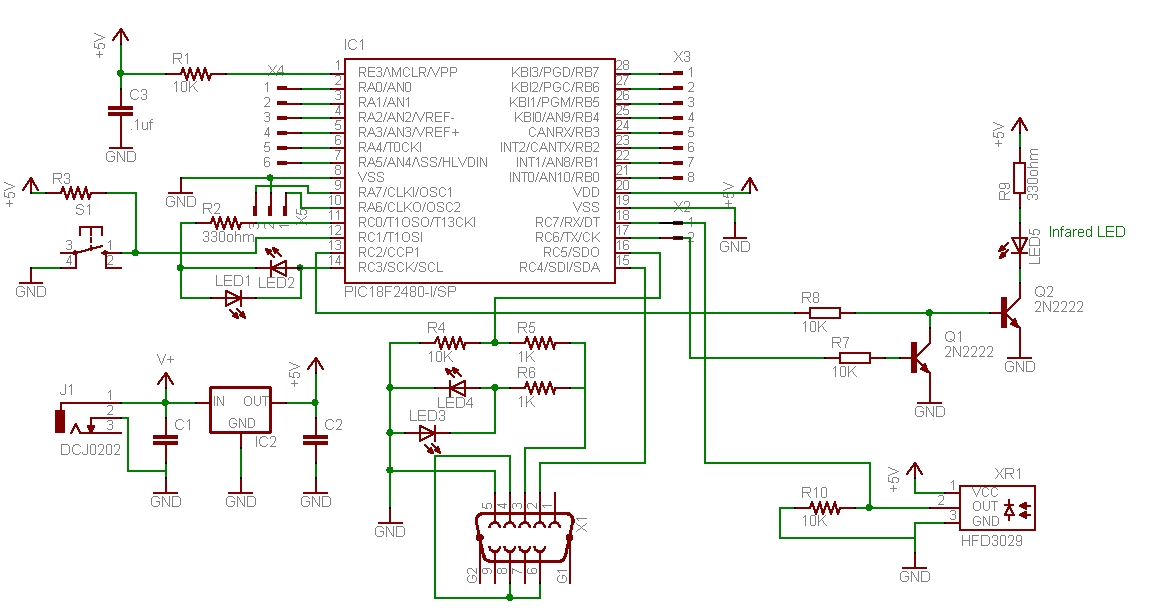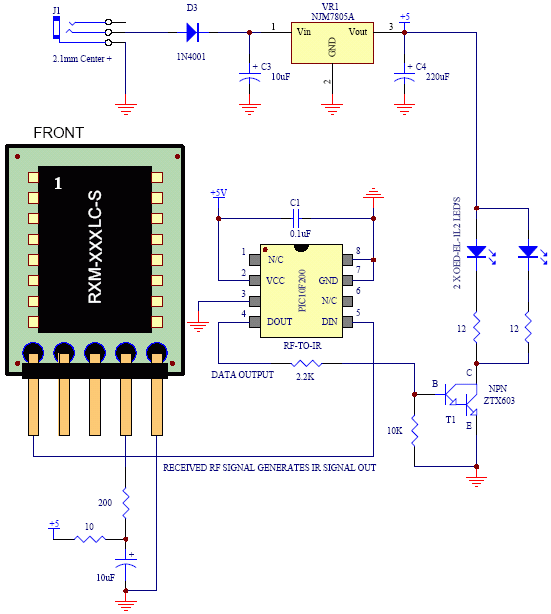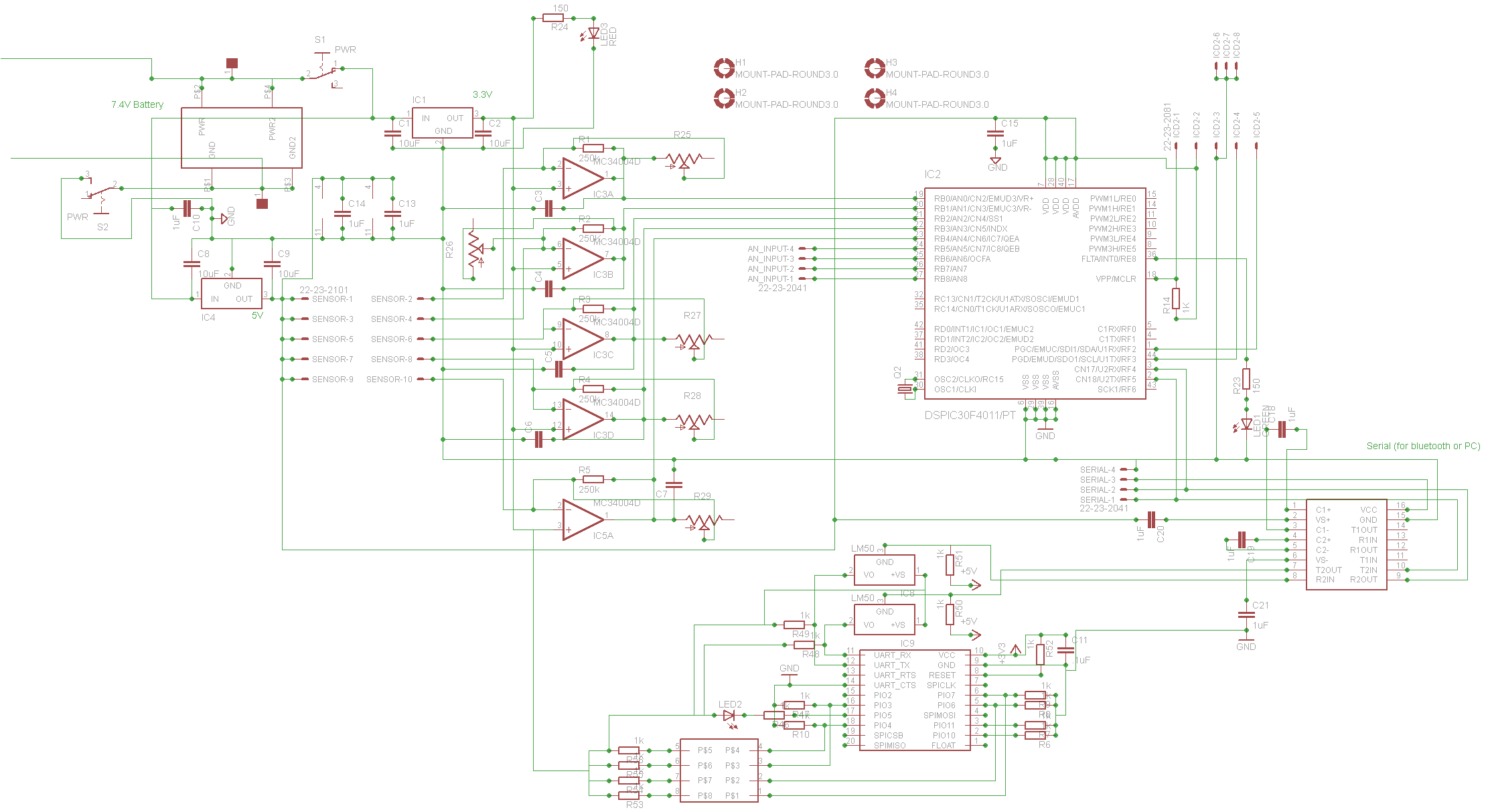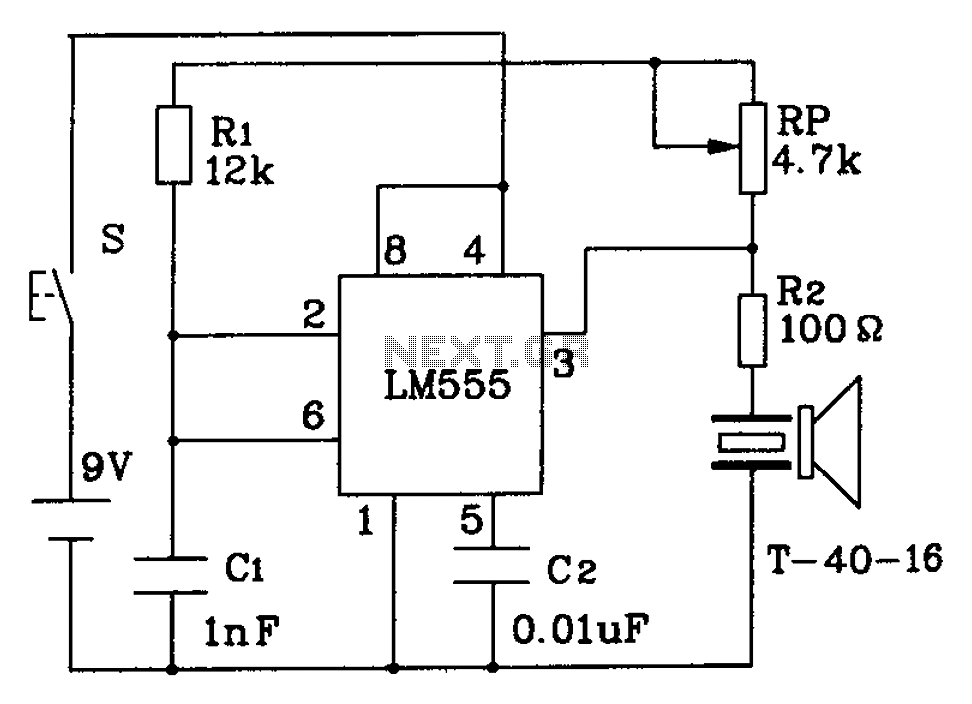
Infrared Transmit and Receive

Whenever an easy method is discovered for accomplishing a task, it is essential to document it. Certain projects may require a wireless solution using the Logochip. The following circuit simplifies this process. First, an explanation of the Radioshack 276-640 IR Receiver Module is provided. This module receives signals from an IR (940nm) LED that oscillates at 38 kilohertz. To transmit a series of bits (1s and 0s), the 38 kHz signal is modulated on and off. Fortunately, the Logochip can generate the 38 kHz signal and modulate it with minimal software effort. The internal timer module will be configured to produce this signal, while the serial UART will handle the modulation. The schematic illustrates the Logochip circuit on the left and the IR transmit and receive circuits on the right. The transmission circuit involves two transistors: one drives the LED using the timer output from PORTC bit 2, which generates a 38 kHz square wave. Typically, this signal is held off by the second transistor, which is driven by the transmit pin (TX) at PORTC bit 6. When the serial port is instructed to transmit an 8-bit byte, the serial data is output from the TX pin, modulating the 38 kHz signal to the LED. On the receiver side, the Radioshack module is simply connected to a 5-volt power supply and ground, with the output signal directed into the receiver input (RX) at PORTC bit 7. A resistor is included to ground to prevent output drift. A breadboard setup is utilized, with the transmit LED and receiver module oriented vertically, allowing for signal reflection.
The schematic design described outlines a basic wireless communication circuit utilizing the Logochip and the Radioshack 276-640 IR Receiver Module. The Logochip serves as the primary controller, generating the necessary 38 kHz modulation signal through its internal timer. The modulation of this signal is achieved via the serial UART, which facilitates the transmission of data in the form of 8-bit bytes.
In the transmission circuit, the first transistor is responsible for driving the IR LED, receiving the square wave output from PORTC bit 2. The second transistor acts as a switch, controlling the LED's operation based on the signal from the transmit pin (TX) at PORTC bit 6. This configuration allows for efficient modulation of the IR signal, enabling the transmission of binary data.
On the receiving end, the IR Receiver Module is straightforwardly connected to a 5-volt power source, with its output linked to the RX input at PORTC bit 7. The addition of a pull-down resistor ensures stability by preventing floating states on the RX input, thus ensuring reliable data reception.
This circuit can be implemented on a breadboard for prototyping, with careful attention paid to the orientation of the IR components to maximize signal transmission and reception. This design not only demonstrates the capabilities of the Logochip in wireless communication applications but also serves as a practical example of integrating IR technology into electronic projects.When ever I find an easy way to do something I just have to make a record of it. There are some projects where you might want to do something wireless with the Logochip. This little circuit makes it pretty easy. First an explination of the Radioshack 276-640, the IR Receiver Module. It will receive signals from an IR(940nm) LED that is oscillati ng at 38killoherts. So if we want to send a series of 1 ²s and 0 ²s we modulate this 38KHz signal on and off. Fortunately the Logochip can produce the 38KHz signal and modulate it with very little effort from the software. G‚ We`re going to set up the internal timer module to produce the signal and set up the serial UART to modulate it.
So here let`s look at the schematic. This schematic shows the Logochip circuit to the left and the IR transmit and receive circuits to the right. There are two transistors involved in the in the transmit. The one that drives the LED is driven by the timer output PORTC bit 2 which is producing a 38KHz square wave.
But most of the time it is being held off by the other transistor which is being driven by the transmit pin (TX) PORTC bit 6. Now when you tell the serial port to transmit an 8 bit byte the serial data comes out of the TX pin and modulates the 38KHz signal on and off to the LED.
On the receiver side (this is really easy) the Radioshack part is simply hooked up to the 5 volt power and ground and the output signal runs right into the receiver input (RX) PORTC bit 7. I put a resistor to ground just in case the output drifts. That`s it. Here`s a picture of my bread board. IRlogoProtoBoard G‚. The transmit LED and the receiver module are pointing straight up and I just help my hand above it to reflect the signal back.
I can`t wait to use it in something. 🔗 External reference
The schematic design described outlines a basic wireless communication circuit utilizing the Logochip and the Radioshack 276-640 IR Receiver Module. The Logochip serves as the primary controller, generating the necessary 38 kHz modulation signal through its internal timer. The modulation of this signal is achieved via the serial UART, which facilitates the transmission of data in the form of 8-bit bytes.
In the transmission circuit, the first transistor is responsible for driving the IR LED, receiving the square wave output from PORTC bit 2. The second transistor acts as a switch, controlling the LED's operation based on the signal from the transmit pin (TX) at PORTC bit 6. This configuration allows for efficient modulation of the IR signal, enabling the transmission of binary data.
On the receiving end, the IR Receiver Module is straightforwardly connected to a 5-volt power source, with its output linked to the RX input at PORTC bit 7. The addition of a pull-down resistor ensures stability by preventing floating states on the RX input, thus ensuring reliable data reception.
This circuit can be implemented on a breadboard for prototyping, with careful attention paid to the orientation of the IR components to maximize signal transmission and reception. This design not only demonstrates the capabilities of the Logochip in wireless communication applications but also serves as a practical example of integrating IR technology into electronic projects.When ever I find an easy way to do something I just have to make a record of it. There are some projects where you might want to do something wireless with the Logochip. This little circuit makes it pretty easy. First an explination of the Radioshack 276-640, the IR Receiver Module. It will receive signals from an IR(940nm) LED that is oscillati ng at 38killoherts. So if we want to send a series of 1 ²s and 0 ²s we modulate this 38KHz signal on and off. Fortunately the Logochip can produce the 38KHz signal and modulate it with very little effort from the software. G‚ We`re going to set up the internal timer module to produce the signal and set up the serial UART to modulate it.
So here let`s look at the schematic. This schematic shows the Logochip circuit to the left and the IR transmit and receive circuits to the right. There are two transistors involved in the in the transmit. The one that drives the LED is driven by the timer output PORTC bit 2 which is producing a 38KHz square wave.
But most of the time it is being held off by the other transistor which is being driven by the transmit pin (TX) PORTC bit 6. Now when you tell the serial port to transmit an 8 bit byte the serial data comes out of the TX pin and modulates the 38KHz signal on and off to the LED.
On the receiver side (this is really easy) the Radioshack part is simply hooked up to the 5 volt power and ground and the output signal runs right into the receiver input (RX) PORTC bit 7. I put a resistor to ground just in case the output drifts. That`s it. Here`s a picture of my bread board. IRlogoProtoBoard G‚. The transmit LED and the receiver module are pointing straight up and I just help my hand above it to reflect the signal back.
I can`t wait to use it in something. 🔗 External reference





